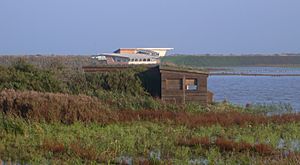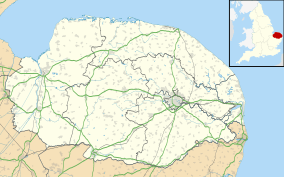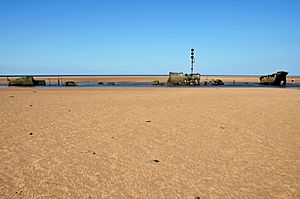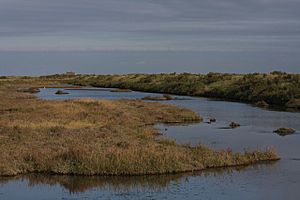Titchwell Marsh facts for kids
Titchwell Marsh is a special nature reserve in England. It's looked after by the Royal Society for the Protection of Birds (RSPB). You can find it on the north coast of Norfolk, between the villages of Titchwell and Thornham. It's about 8 km (5 mi) east of the seaside town of Hunstanton.
This amazing place covers 171 hectares (420 acres). It has different types of habitats like reed beds, saltmarshes, a freshwater lagoon, and a sandy beach. There's even a small wooded area near the car park. Titchwell Marsh is super important for nature. It's part of a bigger protected area called the North Norfolk Coast Site of Special Scientific Interest (SSSI). It's also part of the Norfolk Coast Area of Outstanding Natural Beauty (AONB). Plus, it has special protection under international agreements like Natura 2000, Special Protection Area (SPA), and Ramsar listings.
The reserve is a key home for some rare birds that breed here. You might spot pied avocets on the islands. In the reeds, you can find western marsh harriers, Eurasian bitterns, and bearded reedlings. To help the bitterns, the reed beds have been made wetter. The lagoon has also been filled with common rudd fish for them to eat. Other common wetland birds include the water rail, reed warbler, and sedge warbler. Little egrets are also often seen. Titchwell Marsh is a great spot for migrating birds, so rare visitors often show up. Many ducks and geese spend the winter here. The reserve also protects the European water vole, which is an endangered animal.
Titchwell Marsh has great facilities for visitors. There are three bird hides where you can watch birds without disturbing them. There's also a seawatching platform to look out at the sea. You can explore two nature trails and a visitor centre. Because of worries about climate change, big changes were made in 2010 and 2011. The banks around the freshwater lagoon were improved. A brackish (slightly salty) lagoon was changed into a tidal saltmarsh. This new saltmarsh acts as a better barrier against the sea.
Titchwell Marsh is also important for archaeology. People have found old tools and items here from as far back as the Upper Paleolithic period. There are also remains of military buildings from both the First World War and the Second World War. These include brick walls from a First World War military hospital. You can also see 1940s targets used for armoured vehicles and warplanes during the Second World War.
Contents
Exploring the History of Titchwell Marsh
Ancient Times: How Humans Lived Here Long Ago
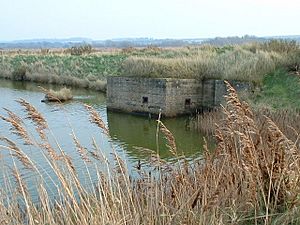
Titchwell has been a home for people for a very long time. Both modern humans and Neanderthals lived in Norfolk before the last Ice Age. They returned after the ice melted. Not many ancient items have been found from very early times. This is partly because the coastline was much further north back then. Many old sites are now under the sea.
Early Mesolithic flint tools have been found at Titchwell. These tools, with long blades up to 15 cm (6 in), show that people lived here when the sea was 60–70 km (37–43 mi) away. Other flint tools from the Upper Paleolithic to the Neolithic periods have also been discovered. As the ice melted, the sea level rose. This filled what is now the North Sea and brought the coast closer to its current line. You can still see remains of ancient forests under the sea at low tide.
People have found signs of two possible wooden platforms in the peat at Titchwell. These might be from prehistoric times. They could tell us a lot about how people built things with wood long ago. Pottery from the Medieval period and later has also been found.
From Farmland to a Nature Reserve: How the Land Changed
People started draining Norfolk's coastal marshes in the late 1600s and 1700s. Sea walls, like the "Old Lord's Bank" at Titchwell, were built. For about 170 years, the land was used for farming crops and raising cattle. In 1853, many Pallas's sandgrouse birds arrived in Britain, and some came to Titchwell.
The area west of Titchwell, called Thornham Marsh, was used as a bombing range by the Royal Flying Corps during the First World War (1914-1918). Some brick walls at Titchwell Marsh are all that's left of a military hospital from that time. A concrete building from the First World War was used as holiday homes. But the British Army took it over again in 1942.
During the Second World War, more military defenses were built at Titchwell. The farmland was flooded again to make it marshy. Zigzag ditches were dug, and small concrete shelters called pillboxes were built. From 1942 to 1945, the marsh was used by the Royal Tank Regiment. They set up a gunnery range for armoured vehicles. They built new banks for firing practice, with targets every 900 m (980 yd). Some islands were made to hold "pop-up" targets, controlled by cables. You can still see parts of the triangular concrete track used by the tanks.
Military activities continued after the war. The Royal Air Force used Thornham Marsh again from 1950 to 1959 for bombing practice. The control tower they used was taken down in 1962. You can sometimes see the remains of two Second World War Covenanter tanks at low tide. They were probably used as targets.
The wreck of the SS Vina, an old cargo ship from 1894, can be seen at low tide. In 1944, a storm dragged her to her current spot and sank her. It's dangerous to visit the wreck because the tide comes in very quickly. A warning sign tells people to return to the beach right away.
After the war, the marshes were drained again for farming. But in the North Sea flood of 1953, the sea broke through the bank. This turned the whole area back into a tidal saltmarsh. A new sea wall was built, creating a shallow freshwater lagoon with a reed bed.
RSPB Takes Over: Protecting Titchwell Marsh for Birds

In the early 1970s, a pair of Montagu's harriers, which are very rare birds of prey in Britain, nested in the reed bed. The RSPB bought the reserve in 1973 to protect it. The Montagu's harriers didn't return, but marsh harriers did. The RSPB started to improve the habitat and build visitor facilities. They built banks around the lagoons and added a car park and visitor centre.
Pied avocets, which were very rare in the UK at the time, first bred here in 1984. The visitor centre was made better between 1987 and 1989 because so many people were visiting.
In 1991, the sea broke through the sand dunes on the beach. The dunes started to wear away. The remains of the Second World War tanks first appeared around this time. A wooden walkway was built in 1992 to protect the dunes. A platform for watching the sea was also added. More land was bought in 1993 to the east of the reserve. This area used to be part of the firing range, so there was a lot of barbed wire to clear!
Storms in 1996 washed away most of the dunes. The visitor centre was made bigger in 1997 and a cafe was added. In 1999, Fen Hide was built with a boardwalk path and a pond for dragonflies.
Today, the reserve is 171 hectares (420 acres) and is very important for birds that breed and spend winter here. It became a Site of Special Scientific Interest (SSSI) in 1973. It's also part of the larger North Norfolk Coast SSSI. It has extra protection from Natura 2000, Special Protection Area (SPA), and Ramsar listings. It's also part of the Norfolk Coast Area of Outstanding Natural Beauty (AONB). Titchwell Marsh is the most visited RSPB reserve, with about 92,000 visitors each year.
Visiting Titchwell Marsh: What to See and Do
Titchwell Marsh is right next to the A149 road, and buses stop outside. The main path to the beach is a public walkway. This is the only part of the reserve where dogs are allowed. The reserve is open all year, and it's free to enter. However, if you're not an RSPB member, you pay to use the car park.
You can get to the main part of the reserve from the visitor centre. There's a 1 km (1,050 yd) path called the West Bank footpath. After leaving the woods near the visitor centre, you'll find two shorter paths. The Fen Trail is 200 m (220 yd) long and leads to a hide overlooking the reed bed. The Meadow Trail is a 100 m (110 yd) loop through wet marsh and past the dragonfly pond.
The main path continues north past the reed bed to the freshwater lagoon and the Island Hide. Then it reaches a bank that goes across the reserve. The new Parrinder hides are along this wall. The path keeps going past a tidal lagoon and over another bank to a saltmarsh. It used to end at a wooden platform on the dunes by the beach, where you could watch the sea.
The visitor centre and shop are open every day except Christmas Day and Boxing Day. Most of the reserve and its facilities are wheelchair accessible. However, the last part of the path to the beach is rough and has a steep bank.
Wildlife at Titchwell Marsh: Birds, Animals, and Plants
Amazing Birds: Who Lives and Visits Here?
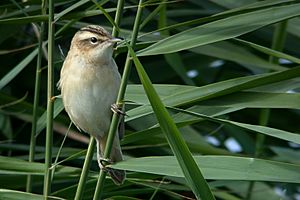
The most important birds that breed here are those that love reed beds. These include the marsh harrier, Eurasian bittern, and bearded reedling. The avocet, which is the RSPB's symbol bird, also breeds here. Bitterns stopped breeding for a while because their habitat wasn't good enough and they didn't have enough large fish to eat. Even though European eels (a favorite food) were there, there weren't enough. To fix this, water levels were managed, and parts of the reed bed were dug out to create open pools. The lagoon was also stocked with common rudd fish. Bitterns started breeding again in 2004. In 2011, there were 80 avocet nests, two pairs of Eurasian bitterns, and four pairs of marsh harriers. The marsh harriers successfully raised seven young birds.
Other birds that breed here include ringed plovers and Eurasian oystercatchers in the sand dunes. Water rails live in the reed bed. Sedge, reed, and Cetti's warblers all nest in the wetlands. Little egrets are now very common. In early summer, rarer migrating birds like the little gull, black tern, Eurasian spoonbills, and garganey might pass through.
In the autumn, birds arrive from the north. Some, like black-tailed godwits, curlew sandpipers, and little stints, are just passing through. They stop for a few days to rest and eat. Others stay for the winter. This is also a good time to see bearded reedlings. Out at sea, you might spot great and Arctic skuas, northern gannets, and black-legged kittiwakes flying by.
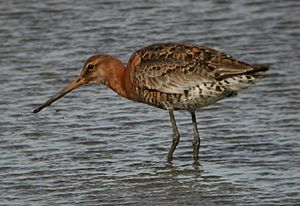
Many ducks spend the winter at the reserve. These include lots of Eurasian wigeons, Eurasian teals, mallards, and gadwalls. You'll also see smaller numbers of goldeneyes and northern pintails. Offshore, there can be huge groups of common scoters. You might also see common eiders, long-tailed ducks, velvet scoters, and red-throated divers. Brent geese eat sea lettuce and other green algae. Hundreds of European golden plovers might rest on the reserve at high tide. In the evenings, large flocks of pink-footed geese fly over Titchwell to their roosting spots. Barn owls and hen harriers hunt over the marshes. This is also the time to see flocks of lesser redpolls, sometimes with a rarer common redpoll. Snow buntings can be found on the beach.
Because of its location, Titchwell is a great place for migrating birds. Sometimes, huge numbers of birds pass through when the weather is right. This can include very rare visitors. Some major rare birds seen recently include a Pacific golden plover and a great knot in 2016. A slender-billed gull and a penduline tit were seen in 2014.
Other Animals and Plants: Beyond the Birds
Water voles are an endangered animal in the UK. Their numbers have dropped a lot, mainly because of American mink (an animal brought here from other countries). But water voles are still common at Titchwell. This makes Titchwell one of the most important places in East Anglia for this species. You can see both common and grey seals off the beach. Other animals include European eels, common toads, and three-spined sticklebacks.
In summer, the dragonfly pond can have up to ten different types of dragonflies and damselflies. A rare moth called the flame wainscot has bred at Titchwell since 1996. Other moths and butterflies you might see include painted lady butterflies. The diamondback moth and especially the silver Y moth can appear in huge numbers. For example, 90,000 silver Y moths were counted in July 2010, feeding on sea lavender.
The saltmarsh has plants like glassworts and common cord grass in the areas closest to the sea. As the marsh grows, other plants appear. First, there's sea aster, then mostly sea lavender. You'll find sea purslane in the creeks. Smaller areas have sea plantain and other common marsh plants. Drier areas have grasses like sea couch grass and sea poa grass. The reed beds are mostly common reed. You'll also see saltmarsh rush, brackish water crowfoot, sea clubrush, and common bulrush in the different wet areas.
Enjoying Titchwell Marsh: Fun Activities and Local Impact
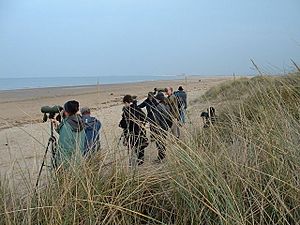
Titchwell Marsh is the RSPB's busiest reserve. This means it brings a lot of money to the local area. A survey in 2002 said that about 137,700 visitors spent £1.8 million locally in 1998. The small village of Titchwell has two hotels and a shop that sells telescopes and binoculars for birdwatching.
A survey in 2005 found that 39 % of visitors to Titchwell and other nearby coastal places said birdwatching was the main reason for their visit. In 1999, about 7.7 million day visitors and 5.5 million overnight visitors came to the area. They spent an estimated £122 million. This spending created jobs for many people.
Protecting Titchwell Marsh: Facing Challenges and Building for the Future
The soft coastline of North Norfolk has been worn away by the sea for hundreds of years. At Titchwell Marsh, the beach and sand dunes that protect the reserve have been eroding. Climate change makes it more likely that the freshwater areas of the reserve will be damaged. Stronger storms, which are predicted, could harm the dune system. This could expose the soft earth banks to waves. Or the sea could simply go over the defenses, like it did in the 1953 floods. Either way, the reserve's value for conservation would be hurt. The bitterns, for example, could be lost.
Instead of just making the outer bank stronger, a plan was made to allow the sea to move inland in a controlled way. Between 2010 and 2011, the banks on the east and west sides of the reserve were made stronger. The sea wall north of the fresh marsh was rebuilt along the old Parrinder bank. The old Parrinder Hide was replaced with two modern hides, keeping the original name. These new hides even won an award for their design!
The area that used to be a brackish (slightly salty) marsh north of the new wall has been changed. A gap was made in the east bank. This lets the tide flood the area, which will eventually become a new saltmarsh called Volunteer Marsh. This new saltmarsh will help protect the rebuilt Parrinder wall by slowing down erosion. Even with these changes, it's thought that by 2060, the beach might have moved halfway across this new tidal area.
Other improvements were made to the reed beds and islands in the freshwater lagoon. A new sluice (a gate to control water flow) was installed. New reed beds were created east of Fen Hide. You can reach these by trails that opened in 2012. Part of the trail is open all year. Another part, the "autumn trail," is open only from August to October.
Images for kids
-
Remains of Second World War coastal defences.
-
The avocet features on the RSPB's logo.
-
Sedge warblers breed in the marsh.
-
Black-tailed godwits of the Icelandic subspecies pass through on migration.
-
Birdwatching visitors help to support the local economy.


